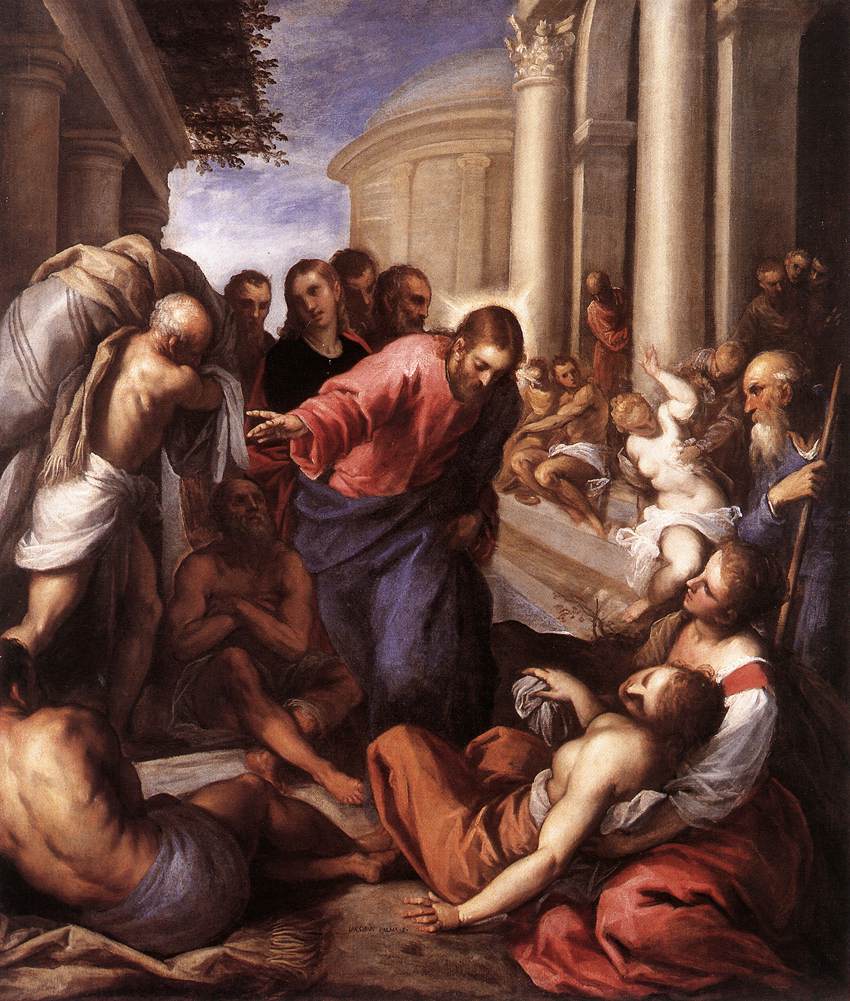As we continue to transverse Bach’s first year in Leipzig, we get to the 19th Sunday after Trinity, for which Bach composed Cantata 48, performed on October 3, 1723. Some of the cantatas preceding this one showed us how he was experimenting with the integration of chorales as structural elements in different ways. Cantata 48 largely continues to paint that picture for us, as we find a chorale inserted, quite unusually, as the third movement of the work. In contrast, there is no delivery of a chorale harmonization embedded in the first movement as we saw in some preceding pieces.
Some patterns occasionally arise also when one examines cantatas chronologically. In this case, we can observe that the scoring for 148 and 48 are almost identical: a trumpet added to the regular orchestra of oboes (no oboe da caccia in 48, though), strings and continuo, with four-part choir and even the same vocal soloists, alto and tenor.
The Gospel for this Sunday (Matthew 9: 1-8) narrates the episode of Jesus healing a man with palsy (paralysis). As in the recent Cantata 25, we are presented with the metaphor of sickness and healing to represent sin and redemption. The anonymous poet opens the libretto with a “dictum”, Romans 7: 24, chose a stanza of a hymn by Martin Rutilius of 1604 for the third movement, and closes the cantata with stanza 12 of the anonymous chorale “Herr Jesu Christ, ich schrei zu dir,” of 1620. The rest of the movements are newly written poetry. So, we have two textual references to chorales, plus a purely musical one: Bach weaves a tune into the first movement, given to the trumpet and the oboes in canon, which is associated with a 1588 text which also draws a parallel between sin and sickness. This evidences how deeply versed Bach was in theology, the Bible and the Lutheran hymnbooks, and highlights his desire (and ability) to convey meaning to his audience through music, without the prompting of a libretto.
Presumably starting with the chorale tune, which he gives to the trumpet to lead and to the oboes to follow in canon (two bars later and a fourth lower), Bach builds the opening movement as a choral scene of yearning and search for salvation, on the text from Romans. With a slow ternary rhythm, clearly stated in quarters and punctuated with rests, he creates an atmosphere of aimless, disoriented wandering. He gives the text to the different voices of the choir on a theme that starts with an upward leap of a sixth (symbolizing a prayer, or an imploration) and quickly a downward appoggiatura (sighing). The voices chase each other in different groupings and successions, contributing to the sense of confusion. It’s fascinating how among all this uncertainty and fragility, the hidden answer is provided right there by the steady, unrelentless delivery of the chorale tune as the backbone of the movement.
The alto recitative that follows, accompanied by strings, uses remarkable harmonic twists and turns to depict the pain and suffering of the afflicted soul. It’s similar in character, although more impassionate in its musical plea, to the tenor recitative of Cantata 25 (“The whole world is just a hospice…”).
As mentioned before, we now encounter a bit of a structural surprise. Instead of following the statement of the anguished believer with a reflective aria, we get some relief in the form of a plain chorale. While the text suggests resignation (“If it must be so… let me atone here”), the final chord is in major mode, providing a bit of a mood uplift.
Next is an alto aria, set as a trio with solo oboe and basso continuo. A ternary meter and a cheerful oboe ritornello emphasize the message of the second section of the text: purify the soul and deliver a holy Zion. Tellingly, Bach does not go “da capo” – he prefers to move on to the “turning point” and shift the mood. This comes in the tenor “secco” recitative that follows, which delivers the good news: Jesus’ power makes the body strong and the soul whole.
Having received the uplifting message, we get to the tenor aria, which is accompanied with strings and oboes (doubling the first violins). Left behind is the cautious optimism of the alto aria: this one is a jubilant movement, again in triple time but with constant hemiolas that portray a joyful swinging character. However, it’s set in minor mode, which reminds us that while the long-term prospects are optimistic, we have to endure suffering before we get there. Julian Mincham calls this movement “an aria for the here and now”.
The closing chorale, in four parts with the instruments doubling the voices, harmonizes the same chorale tune that we heard blended into the opening movement, thus giving the cantata musical unity.
